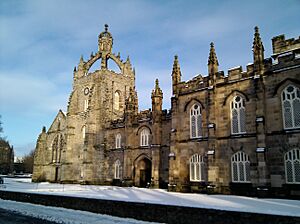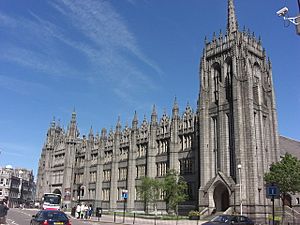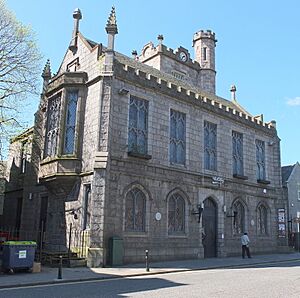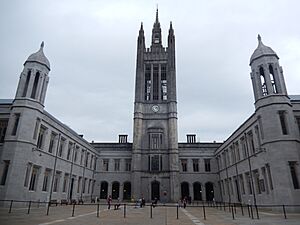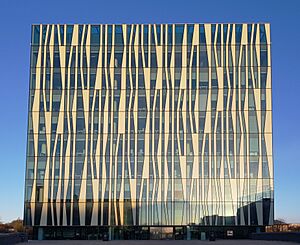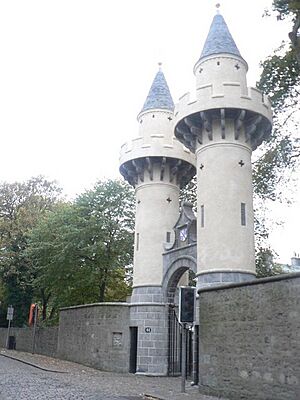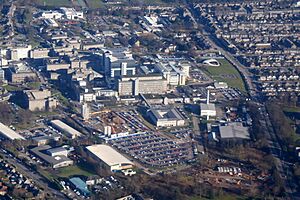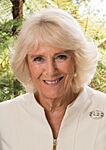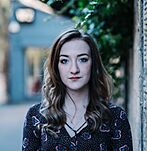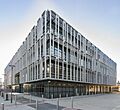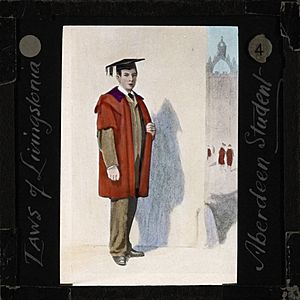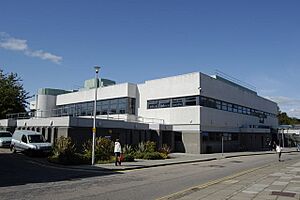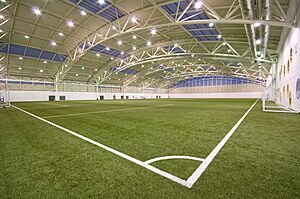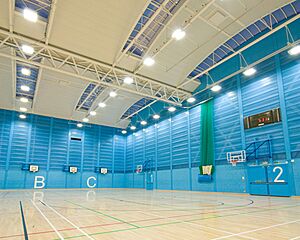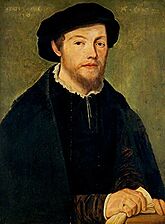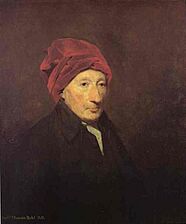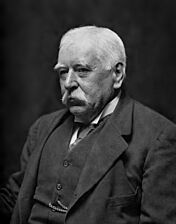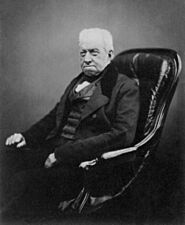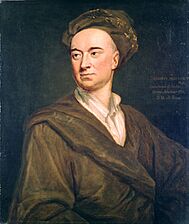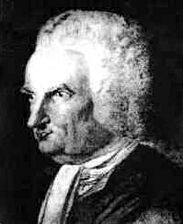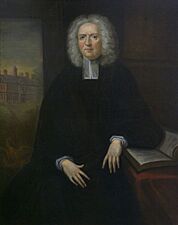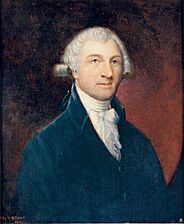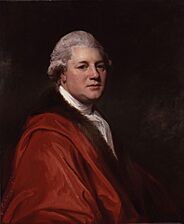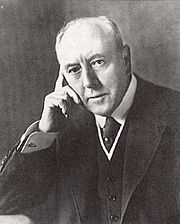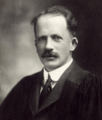University of Aberdeen facts for kids

Coat of arms of the University of Aberdeen
|
|
| Latin: Universitas Aberdonensis | |
| Motto | Latin: Initium sapientiae timor domini |
|---|---|
|
Motto in English
|
The fear of the Lord is the beginning of wisdom |
| Type | Public research university Ancient university |
| Established | 1495 |
| Endowment | £65.3 million (2024) |
| Budget | £264.0 million (2023/24) |
| Chancellor | Queen Camilla |
| Rector | Iona Fyfe |
| Principal and Vice-Chancellor | George Boyne |
|
Academic staff
|
1,695 (2023/24) |
|
Administrative staff
|
1,845 (2023/24) |
| Students | (2015/16) 12,070 FTE (2015/16) |
| Undergraduates | (2015/16) |
| Postgraduates | (2015/16) |
| Location |
,
Scotland, UK
57°09′55″N 02°06′08″W / 57.16528°N 2.10222°W |
| Campus | Urban, across two main sites |
| Colours |
Burgundy and white
(university colours) Gold and royal blue (sports colours)
|
| Affiliations |
|
| Mascot | Angus the Bull |
 |
|
The University of Aberdeen is a public university in Aberdeen, Scotland. It's a place where people go to study and do important research. It was started in 1495. William Elphinstone, who was the Bishop of Aberdeen, asked Pope Alexander VI to create King's College. This makes it one of Scotland's four oldest universities. It is also the fifth-oldest university in the English-speaking world.
The university we know today was formed in 1860. This happened when King's College joined with Marischal College. Marischal College was another university founded in 1593. It was created as a Protestant option to King's College. The university's famous buildings, like Marischal College and the crown steeple of King's College, are well-known symbols of Aberdeen.
The university has two main campuses. The King's College campus is used the most. It is in a part of the city called Old Aberdeen, about two miles north of the city centre. Most of the buildings there were built in the 1900s. The university's Foresterhill campus is next to Aberdeen Royal Infirmary. This campus is home to the School of Medicine and Dentistry. These buildings together form one of Europe's largest health campuses.
Many famous people have studied at Aberdeen. The university played a big part in important historical periods. These include the Scottish Reformation, the Scottish Enlightenment, and the Scottish Renaissance. Five Nobel Prize winners have also been connected to the university.
Contents
A Look at History
The First Colleges: King's and Marischal
Long ago, there was a school in Old Aberdeen connected to the church. It was founded around 1157. However, it seems it wasn't enough for the people of northern Scotland. King James IV asked Pope Alexander VI to start a new university. He wanted to help the people learn more and train more church leaders.
The first university in Aberdeen was King's College. It was officially started on February 10, 1494. William Elphinstone, the Bishop of Aberdeen, made the request for King James IV. The Pope agreed and issued a special document called a papal bull. King James wanted Scotland to have as many universities as England. This new university was meant to have all the same benefits as famous universities in Paris and Bologna.
King's College was mainly a law school. It quickly became very popular. This was thanks to William Elphinstone and his friend, Hector Boece, who became the first principal in 1500. The goal was to train doctors, teachers, and church leaders for northern Scotland. It also trained lawyers and administrators for the Scottish King. In 1497, the college started the first medical teaching position in the English-speaking world.
After the Scottish Reformation in 1560, King's College changed some of its staff. But it mostly stayed the same. In 1593, George Keith started a second university in the 'New Town'. This was Marischal College. It was unusual for one city to have two universities. At that time, England only had two universities: University of Oxford and University of Cambridge.
At first, the two colleges were rivals. Marischal College was in the busy city centre. It was different from King's College, which was in the older, quieter part of town. Marischal College allowed students to live outside the college, which was new. The two colleges often argued and even had fights between students. In 1613, the first math teaching position was created at Marischal College.
Over time, the colleges started to get along better. They even tried to merge in the 1600s. Both colleges made important contributions during the Scottish Enlightenment. They both supported the Jacobite rebellion. After the rebellion failed in 1715, many of their staff were removed.
Joining Forces: The University of Aberdeen is Formed
The closest the two colleges came to joining was in 1641. King Charles I brought them together as the Caroline University of Aberdeen. This lasted for twenty years. A more complete merger happened in 1654 under Oliver Cromwell. But when King Charles II returned to power, the colleges became separate again. King Charles I is still seen as one of the university's founders.
A group called the Aberdeen Philosophical Society, also known as the Wise Club, started in 1758. Its members were learned people who discussed ideas. They played a key role in the Scottish Enlightenment. Many of their discussions led to published books. The society ended in 1773 but was restarted in 1840.
In 1843, the Free Church of Scotland started Christ's College to train ministers. A grand building was built for it in 1850. This college later joined the University of Aberdeen in 1929.
In 1859, the university hosted a big science meeting. The town built the Music Hall to hold about 2,500 people. Many important scientists attended. James Clerk Maxwell, a professor at Marischal College, spoke about his new law of molecular velocities in gas. This is now known as the 'Maxwell distribution law'.
The two colleges finally merged on September 15, 1860. This happened because of a law called the Universities (Scotland) Act 1858. This law also created a new medical school at Marischal College. Because of this merger, the University of Aberdeen is Scotland's third oldest university. It is the fifth oldest in the United Kingdom.
After the merger, King's College was expanded. New buildings were added for classrooms and a library. In 1873, students voted against women being able to get university degrees. However, by 1892, all subjects were open to women. In 1894, the first 20 female students began their studies. By 1899, women made up a quarter of the students in the arts subjects.
The University Today
The main part of Marischal College was finished in 1906. King Edward VII and Queen Alexandra officially opened it. There were big celebrations in Aberdeen with parties and fireworks. Many important people from around the world received honorary degrees.
In the 1900s, the university grew a lot, especially at King's College. New buildings were added around King's College. Some matched the old style, like the New King's lecture rooms. Later buildings, from the 1960s, were built in a modern, strong style called brutalist. The Foresterhill campus also started training medical students in the 1930s.
Over time, many departments moved from Marischal College to King's College. By the late 1900s, most of Marischal College was no longer used by the university. Today, Marischal College is the headquarters for the Aberdeen City Council. The university still uses a small part of it for the Marischal Museum.
A new university library, the Sir Duncan Rice Library, opened in 2011. It cost £57 million. Queen Elizabeth II officially opened it in September 2012. This library replaced the older Queen Mother Library. Most students now spend their time in modern buildings with up-to-date facilities. However, the old buildings at King's College are still used for classes and offices.
In 2020, an investigation found that the university had not managed public funds well in one case. As a result, the university had to pay back £119,000.
Modern Languages Department
In December 2023, the university looked at changing how modern languages were taught. They considered ending single degrees in French, Gaelic, German, and Spanish. This was because fewer students were choosing these subjects. Staff and students were worried about these changes.
A group of professors said these changes would be "institutional vandalism." They pointed out that Aberdeen would be the first ancient university in the world not to offer language degrees. A public petition to save the languages gained over 18,600 signatures. Many people, including EU consulates, supported keeping the language programs. In March 2024, the university decided to keep the modern language degrees.
University Buildings and Campuses
The university's main campus is at King's College in Old Aberdeen. The original buildings are still used, along with many newer ones. A second campus at Foresterhill has the School of Medicine, Medical Science and Nutrition. There are also smaller places like the Royal Cornhill Hospital and the Rowett Institute.
Current Campuses
King's College Campus
The King's College campus covers about 35 hectares. It is around the old King's College buildings. Most of the university's buildings and student facilities are here. It is about 2 miles north of Aberdeen city centre. You can get there by bus from the city centre.
The historic King's College buildings form a square with a courtyard inside. The Crown Tower and the chapel are the oldest parts, from around 1500. The Crown Tower has a unique crown shape on top. This "Crown of Kings" is a symbol of the university. The chapel has beautiful old wooden seats and screens. These were saved during the Reformation.
The first modern building, "New King's," was built in 1913. It looks similar to the old buildings. The Elphinstone Hall, built in the 1930s, is now used for graduations and other big university events.
Most students and staff use the many modern buildings. These buildings have up-to-date facilities. Some, like the Fraser Noble Building, have designs that remind you of the old architecture. Others, like the Arts Lecture Theatre, are in the brutalist style. The Cruickshank Botanic Garden is also on campus and is open to the public.
The Powis Gateway is an interesting archway with towers that look like they have minarets. It has coats of arms of old landowners.
The Sir Duncan Rice Library was finished in 2011. It was designed by Danish architects. Queen Elizabeth II opened it in September 2012. This seven-story building is covered in white and clear glass stripes. It is the university's main library. You can see great views of the city from its top floors. It holds over a million books, including many old and valuable ones.
The newest building is the Science Teaching Hub, completed in 2021. It has laboratories for subjects like biology, chemistry, and medical sciences. The Aberdeen Sports Village is across King Street. It has sports facilities and a swimming centre.
Foresterhill Campus
The Foresterhill Campus is about 1.75 kilometers (1.1 miles) from the Old Aberdeen campus. It is where the university's Life Sciences and Medicine facilities are. It is next to Aberdeen Royal Infirmary and other hospitals. These are all teaching hospitals. This campus has the School of Medicine, Medical Science and Nutrition and the School of Psychology. The university has been at Foresterhill since about 1938.
Doha, Qatar Campus
A new campus opened in Doha, Qatar, in May 2017. It is called AFG College with the University of Aberdeen. It offers courses in accounting, finance, and business management.
Former Campuses
Marischal College
Marischal College is a beautiful building that looks like an old Gothic castle. It was rebuilt in 1836–41 and made much bigger later. King Edward VII opened the additions in 1906. The building is considered one of the best examples of this style in Great Britain. The Mitchell Tower at the back is named after a generous donor.
Until 1996, Marischal College had science departments. But now, most university teaching does not happen there. The building is mostly leased to Aberdeen City Council for their offices. The university still uses a small part for the Marischal Museum.
Hilton Campus
A small campus at Hilton joined the university in 2001. It was home to the Faculty of Education for a while. But after new facilities were built at King's College, the Hilton campus closed in 2005. It was sold and is now a residential area.
How the University is Run
Governance
Like other old Scottish universities, Aberdeen's rules are set by laws from 1858. The university has three main parts that help run it:
- The General Council: This is for senior academics and graduates.
- The University Court: This group handles money and administration.
- The Academic Senate (Senatus Academicus): This is the main academic body.
There are also three main leaders of the university. The Chancellor is mostly a ceremonial leader. The Rector is chosen by the students to represent them. The Principal and Vice-Chancellor is the main administrative head.
University Leaders
The three most important leaders are the Chancellor, Principal, and Rector. Their roles come from the 1858 law.
The Chancellor is the university's official head. Since 2013, Queen Camilla has been the Chancellor. She is the first female Chancellor of the university. The Chancellor gives degrees to students who graduate.
The Principal and Vice-Chancellor is Professor George Boyne. He started his role on August 1, 2018. He is in charge of the university's daily operations.
The Rector is chosen by the students every three years. The Rector leads meetings of the University Court. They also share student opinions with the university leaders. In November 2024, Iona Fyfe, a Scottish folk singer, was chosen as the new Rector. Famous past Rectors include Winston Churchill and Andrew Carnegie.
The University Court
This group was created in 1870 when King's and Marischal colleges merged. It helps manage the university's money and property.
Senatus Academicus
The Academic Senate is the top academic group for the university. It includes all the professors and other senior teachers. It is in charge of approving degree programs and giving out degrees. It also handles student rules. The university Principal leads the Senate.
Schools and Institutes
The university has 12 schools. These schools cover many different subjects. Larger schools are divided into three teaching colleges. The university also has research centers. These allow experts to work together on new research projects.
|
|
|
|
|
-
Zoology Building, University of Aberdeen - geograph.uk - 858110.jpg
Zoology Building
Finances
In the financial year ending July 31, 2024, Aberdeen had a total income of £264 million. Its main sources of money were tuition fees, government grants, and research grants. The university also has an endowment of £65.3 million.
University Symbols
The university's coat of arms is part of its logo. It uses the colors burgundy and white. These are seen on signs, printed materials, and online.

Coat of Arms
The university's coat of arms combines symbols from its founders and locations. The top left shows the arms of Old Aberdeen. The top right shows the arms of George Keith. The bottom left shows the arms of Bishop William Elphinstone. The bottom right has a simpler version of the three castles that represent the city of Aberdeen.
Motto
The university's motto is Initium Sapientiae Timor Domini. This is Latin for "The beginning of wisdom is fear of the Lord." It comes from the Bible. You can see the motto on an archway at the King's College campus. It is also on graduation certificates.
Tartan
A special university tartan was created in 1992. This was for the university's 500th anniversary in 1995. The tartan uses colors from the university's coat of arms.
Academic Dress
Students at the University of Aberdeen have worn special academic clothes since medieval times. In the past, undergraduate students wore scarlet gowns and a square cap. But this tradition faded by the mid-1900s.
Today, academic dress is usually worn for special events. These include graduation ceremonies or academic parades. For most degrees, students wear a long black gown. They also wear a hood lined with a color that shows their subject. For example, arts degrees have white silk lining. A black square cap is also worn. For PhD degrees, a scarlet robe is worn with a special black cap.
Academics
Term Dates
The academic year at Aberdeen used to follow old Scottish dates. Now, it is divided into two semesters. The first semester starts in September. The second semester ends in May. Exams are in November and in April/May. Graduation ceremonies are in November or at the end of June.
Rankings and Reputation
| National rankings | |
|---|---|
| Complete (2021) | 30 |
| Guardian (2021) | 12 |
| Times / Sunday Times (2021) | 15 |
| Global rankings | |
| ARWU (2020) | 201–300 |
| QS (2021) |
262= |
| THE (2021) | 201–250 |
Aberdeen is often ranked among the top 200 universities in the world. It is also in the top 20 universities in the United Kingdom. In 2019, it was ranked 31st in the world for its impact on society. The Times and Sunday Times Good University Guide named Aberdeen the 2019 Scottish University of the Year. More than 75% of the university's research is considered 'world leading'.
Its highest-ranked subject internationally is Divinity and Religious Studies. Many of its subjects are in the top 10 in the UK. These include Accounting & Finance, Civil Engineering, Computing Science, Dentistry, Education, Law, Medicine, and Physics.
Partnerships
In 2022, the university joined an international group with the University of Calgary in Canada and Curtin University in Australia. They work together on global challenges. The university is also part of the University of the Arctic. This allows students to study in different parts of the North.
Admissions
|
| Domicile and Ethnicity | Total | ||
|---|---|---|---|
| British White | 62% |
|
|
| British Ethnic Minorities | 14% |
|
|
| International EU | 4% |
|
|
| International Non-EU | 18% |
|
|
| Undergraduate Widening Participation Indicators | |||
| Female | 59% |
|
|
| Private School | 12% |
|
|
| Low Participation Areas | 8% |
|
|
Aberdeen is ranked highly for the average scores students need to get in to study there. The university works to help students from all backgrounds attend.
Lecture Series
The Gifford Lectures started at the university in 1887. Many famous thinkers have given these lectures. The university also hosts the annual Andrew Carnegie Lecture Series. The Elphinstone Institute has its own monthly lecture series. These talks are usually about local or Scottish topics.
Libraries and Museums
The university library has one of the largest collections in the UK. It has over a million books. It also has a quarter of a million old and valuable books and manuscripts. The original library at King's College was started with books left by William Elphinstone.
The Sir Duncan Rice Library opened in 2012. It was designed by Danish architects and has won many awards. It is a tall, modern building with great views. It also has public exhibition space. Other libraries include the Taylor Law Library and the Medical Library at Foresterhill.
The university has several museums and galleries. They are free to visit. The collections are very important and recognized nationally. The Zoology Museum has displays of animals from tiny creatures to large whales.
Student Life
As of the 2023/24 school year, the university had over 17,000 students. About 46% were men and 54% were women. Students came from 120 different countries. The university offers more than 550 different undergraduate degrees. It also has over 120 postgraduate programs.
Students' Association
The students are represented by the Aberdeen University Students' Association (AUSA). The elected Rector of the University of Aberdeen also represents students. AUSA helps students and provides places for events and studying.
"The Hub" is a university-owned dining and social center. It opened in 2006. The Butchart Student Centre opened in 2009. It is the main office for the Students' Association. It has many facilities for student groups. AUSA now operates out of the Johnston Building.
Student Clubs and Groups
There are over a hundred clubs and societies for students. The Aberdeen University Sports Union manages sports at the university. All students can join these clubs or societies.
The oldest student group is the Aberdeen University Debater, started in 1848. The first permanent home for the debating society was in Marischal College. The debating room there is Scotland's oldest purpose-built one.
The Aberdeen Future Fund was started in 1998. It raises money for student projects. These have included books for the library and training equipment for medical students.
Sports Clubs
The Sports Union has over fifty sports clubs. There are large playing fields behind King's College. The Aberdeen Sports Village opened in 2009. It is a partnership between the university, Aberdeen City Council, and sportscotland. It has many sports facilities and a swimming center.
The Aberdeen University Football Club started in 1872. The Aberdeen University Rugby Football Club started in 1871. It has a history of producing famous players.
The annual boat race between Aberdeen University Boat Club and Robert Gordon University Boat Club has been held since 1995. The University of Aberdeen has won most of these races.
Music
The university has many music groups. Some are led by professors, and others by students. These include a Big Band, Chapel Choir, and Symphony Orchestra.
The Aberdeen Student Show is a musical comedy show. It has been performed every year since 1921. It raises money for charity.
Student Media
The first successful university newspaper was Alma Mater, started in 1883. It was replaced by The Gaudie, which has been published since 1934. The Gaudie is one of the oldest student newspapers in Scotland.
Traditions
Sponsio Academica
The Sponsio Academica is an oath that students used to take when they started at the four old Scottish universities. Now, at Aberdeen, students agree to it online. Medical students still say a special version of this oath when they graduate.
Founders' Day
Founders' Day is usually held every February. On this day, the university celebrates its history. It especially honors William Elphinstone and others who helped start the university. The ceremony includes a procession and a service in King's College Chapel. A candle is lit to thank the founders.
Installing the Rector
The Rector is an old position from 1495. The Rector represents the students. A tradition says that the new Rector must ride through Old Aberdeen on a bull carried by students. This ceremony includes a colorful parade. After the ceremony, the Rector is carried to a local bar. There, tradition says they buy drinks for their student supporters.
Bajan
"Bajan" is an old word for first-year undergraduate students. Female first-year students were called "bajanellas." Second-year students were called "Semis." Semis would sometimes play tricks on the Bajans.
These terms were based on the four years of the degree:
- B: first year (bajan)
- S: second year (semi)
- T: third year (tertian)
- M: fourth year (magistrand)
Famous People from the University
-
George Wishart, an early Protestant reformer.
-
Thomas Reid, who started the Scottish School of Common Sense.
-
Alistair Darling, a former government minister.
-
Tessa Jowell, a former government minister.
-
Gilbert Burnet, an adviser to William III.
-
Patrick Manson, who started the study of tropical medicine.
-
Alexander Bain, a philosopher and psychologist.
-
Robert Brown, a botanist who discovered Brownian motion.
-
John Arbuthnot, a scientist and writer.
-
Sir James Mackintosh, a philosopher and politician.
-
James Burnett, Lord Monboddo, a lawyer who thought about Darwinian evolution early on.
-
James Gregory, a mathematician who designed the first reflecting telescope.
-
James Blair, who founded The College of William and Mary.
-
William Thornton, a doctor and architect of the United States Capitol.
-
James Gibbs, an architect.
-
Iain Glen, an actor.
-
James Macpherson, a writer and poet.
-
Robert Davidson, who invented the electric locomotive.
- Nobel Prizes (alumni and faculty)
-
Frederick Soddy, Nobel Prize in Chemistry.
-
John Macleod, Nobel Prize in Medicine
-
George Paget Thomson, Nobel Prize in Physics
-
John Boyd Orr, Nobel Peace Prize
-
Richard Laurence Millington Synge, Nobel Prize in Chemistry
See also
- Ancient universities
- List of universities in the United Kingdom


